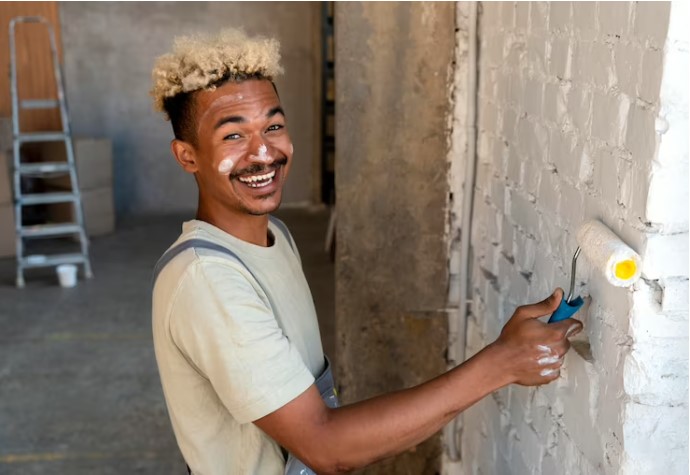Every constructor knows why plastering is essential for any construction project. Without it, your property might come tumbling down sooner or later. But did you know there are different plastering methods, each with unique properties ideal for different environments?
Whether you’re renovating your home or building rental properties, we’ll walk you through the different plastering methods to help you make an aesthetically appealing and durable choice.
Traditional Plastering Methods
Conventional plastering methods have existed for centuries and are still practiced due to their durability, versatility, and aesthetic appeal. Here are some popular options available:
Wet Plastering
This method involves applying a wet mix of cement, sand, and water onto walls or ceilings and is ideal for rough or uneven surfaces that require more preparation before plastering. It’s also good for smoothening and levelling surfaces before painting or wallpapering.
Wet plastering is often used in restoration projects or homes with historical or architectural significance because it mimics original plasterwork. However, it needs a skilled tradesman to get the desired finish and is more time-consuming than other methods.
Lime Plastering
This method uses a mix of lime putty and sand to smoothen surfaces like walls, ceilings, and floors. It’s ideal for older properties or buildings with a traditional or historic look.
Similarly, lime plastering is especially useful in damp or humid environments as it creates a breathable finish and prevents moisture from building up on walls. Still, it requires a skilled craftsman to get the desired finish and can be more expensive
Dry Lining Plastering
Also known as drywall or plasterboard, dry lining plastering involves using pre-made plasterboard sheets attached to the surface with adhesive or screws. This method is good for new build projects or smoothening and levelling surfaces over existing walls or ceilings.
Additionally, it’s quick, easy, less messy, and more cost-effective than other methods like wet plastering. However, it isn’t suitable for achieving a traditional or textured finish.
Modern Plastering Methods
Contemporary plastering methods use synthetic materials and techniques to plaster walls and ceilings. They’re widely used in modern construction due to their convenience, efficiency, and availability of materials. Here are some popular examples:
Gypsum plastering
This method is easy to use, versatile, and popular for modern projects. The plaster is a white powder mixed with water to create a paste that’s applied to interior walls and ceilings using a towel.
Gypsum plaster is good for low-humidity areas because it has poor water resistance properties. Therefore, it’s unreliable for bathrooms or kitchens but an excellent choice for interior walls and ceilings in dry rooms like bedrooms, living rooms, and offices.
Additionally, the plastering sets quickly, is less likely to shrink or crack, and has excellent insulation properties, making it a low-maintenance and energy-efficient choice.
Cement Plastering
This choice is good for interior and exterior plastering projects and involves mixing cement, sand, and water to create a paste applied to the surface. It’s ideal for high-moisture or heavy-traffic areas like bathrooms, kitchens, and commercial spaces.
The plastering is durable, weather-resistant, and a good insulator, making it an energy-efficient choice. Similarly, it’s suitable for decorative applications because it can be finished with different textures and colours.
Polymer-Based Plastering
This plastering method uses a mixture of polymer, cement, and sand to create a durable and flexible plaster for high-humidity or heavy-traffic areas like bathrooms, kitchens, and commercial spaces. It’s applied in thin layers reinforced with a fibreglass mesh to create a strong, durable surface that can be finished with different textures and colours.
Polymer-based plastering also has good sound insulation properties, making it an ideal choice for music studios and other spaces where noise reduction is important.
Specialized Plastering Methods
These methods use specific techniques or approaches to plaster walls and ceilings in unique situations or for specific reasons. They’re different from traditional and modern plastering methods in terms of materials, application techniques, or specific ingredients. Here are some examples:
Venetian Plastering
If you want to add a touch of elegance and luxury to your space, Venetian plastering is a good start, It’s a durable option that involves applying several thin layers of plaster to create a smooth, glossy finish made of marble dust and lime putty.
The method is commonly used to achieve an upscale look in high-end commercial and residential properties, especially for living rooms, dining rooms, hallways, and foyers. It’s also ideal for creating feature walls, columns, and arches.
Insulated Plastering
This specialized plastering technique involves applying a plaster coating with insulating properties to improve a building’s energy efficiency. It’s commonly used in properties like passive houses or areas with extremely low temperatures. It can also be used in existing buildings as a renovation project to reduce heating costs.
Acoustic Plastering
This plastering method involves applying plaster coating with sound-absorbing properties to reduce the amount of sound reflected back into the room. It’s ideal for music studios, conference rooms, auditoriums, and cinemas. It can also be used for residential properties, specifically in rooms that generate high noise levels, like home theatres and children’s playrooms.
Beyond the White Coat
Choosing the right plastering method for your project will depend on several factors, including cost, efficiency, durability, and aesthetics. However, at the end of the day, a properly executed plastering job can enhance any property’s aesthetic appeal and functionality. If you need construction plastering handled perfectly, you need professionals like R&B Plastering by your side. Contact us today to get a quotation for your next project today.






